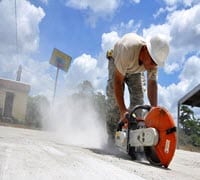New OSHA Regulations on Silica Take Effect June 23
About two million construction workers are exposed to hazardous silica dust on jobsites, according to the Occupational Safety and Health Administration (OSHA). While regulations limiting silica exposure on the job have been in effect since 1971, and have led to significant reduction in silicosis deaths, OSHA, in a bid for greater construction safety, is about to begin enforcing even stricter rules to protect workers who cut, grind, chip, and drill concrete. Contractors in New England should be particularly conscientious, as OSHA already concentrates considerable resources to enforcement in the region.
Beginning June 23, construction companies must implement engineering and/or workplace controls to ensure workers are exposed to an average of less than 50 micrograms of silica per cubic meter during each eight-hour shift. These new permissible exposure levels are about 80 percent lower than the current limits. Companies can comply with the silica rule either by adopting OSHA-approved, task-based methods for reducing silica production or measuring worker exposure and adopting their own methods for keeping it below the new threshold.
Brief OSHA Regulation Breakdown
OSHA outlines its approved mitigation practices in Table 1 of the regulation. For example, the table specifies handheld grinders for mortal removal should be equipped with shrouds and dust-control systems capable of providing a minimum of 25 cubic feet per minute of airflow per inch of wheel diameter. They must include a filter with at least 99 percent efficiency and a pre-separator or filter cleaner attached. Operators must also wear respirators. OSHA has promulgated accepted measures for walk-behind saws and milling machines, hand-held tools, jackhammers, and other equipment. The dust-control system requirements are designed to prevent as much silica dust as possible from becoming airborne, while the respirator requirement aims to protect workers from breathing in the dust that does escape into the air.
Alternative Construction Safety Measures
Contractors that do not implement OSHA’s approved methods must test airborne crystalline silica and provide construction safety tools and equipment to ensure worker exposure remains below the permissible limit. Several methods may be appropriate, depending on the work conditions:
- Wet cutting – Water is delivered to cutting blades and bits to keep dust out of the air.
- Limit use of fine cutting tools – Break concrete into larger pieces to reduce the dust created.
- Incorporate vacuums equipped with HEPA filters – High-efficiency particulate air filters can remove well over 99 percent of dust particles from the air.
- Use respirators – Must be used by all workers in the area, not just tool operators, when other measures cannot clean the air sufficiently.
- Physically seal off work areas where silica dust is created – This protects workers and excuses everyone but the operator from wearing a respirator.
The alternative control methods require complete and accurate records of all silica-level measurements taken, including the date, task tested, methods used for sampling and analysis, and results.
Other Silica-related Requirements
All contractors, regardless of whether they opt for the OSHA-recommended procedures or they “measure and mitigate”, must also adhere to several other construction safety precautions, including:
- Preparation of a written plan for protecting workers from silica dust
- Designation of a “competent person” with the knowledge and authority to carry out the plan, including ordering additional safety measures when needed
- Safety training of workers tasked with working with concrete
- Provision of medical exams every three years for workers who wear respirators for 30 days or more per year.
To learn more about OHSA’s new silica rule and how to prepare your company and equipment for June 23, call Pro Tool experts at 1-857-706-2980.



